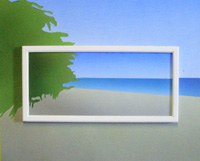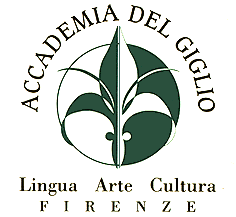 What you are going to read is the speech that I, Roberto Balò, and Professor Paolo Santagati made on July 2nd 2006 at the 3rd Sifnean Symposium that took place every four years on the island of Sifnos in Greece. The main subjects of the symposium were archaeology and history of the Cyclades, but there was also an important section on local folk art and literature. The aim of our speech was to demonstrate how the Island of Sifnos has influenced the works of the Tuscan artist Paolo Galletti. The great turning point of his Art is undoubtedly the encounter with this island. Galletti passed from an idea of painting, which he himself defined geometrical-abstract to a different approach. For the first time he started to introduce in his works architectonical and natural elements such as temples, typical Greek buildings, see shores and rocks. Some examples of his works are on this flickr page.
What you are going to read is the speech that I, Roberto Balò, and Professor Paolo Santagati made on July 2nd 2006 at the 3rd Sifnean Symposium that took place every four years on the island of Sifnos in Greece. The main subjects of the symposium were archaeology and history of the Cyclades, but there was also an important section on local folk art and literature. The aim of our speech was to demonstrate how the Island of Sifnos has influenced the works of the Tuscan artist Paolo Galletti. The great turning point of his Art is undoubtedly the encounter with this island. Galletti passed from an idea of painting, which he himself defined geometrical-abstract to a different approach. For the first time he started to introduce in his works architectonical and natural elements such as temples, typical Greek buildings, see shores and rocks. Some examples of his works are on this flickr page.
Special thanks for their help to: Lorenzo Capanni, Cecilia Pontenani (from the AdG staff), Laura Galletti, Francesco Bruni and Professor Joseph Luzzi (from Bard College – NY).
Paolo Galletti in Sifnos: between tradition and modernity
by Roberto Balò and Paolo Santagati
If we try to trace out the creative path of an artist we should be aware of the fact that every artistic experience is influenced and affected by some particular events, which take place in the artist’s life and which are often related to each other. Such events may sometimes transform the artist’s works as well as affect his way of thinking deeply. Generally speaking the causes of these changes can be attributed to several different factors, such as historical events, philosophical or religious revelations, but in the case of the painter Paolo Galletti the great turning point is undoubtedly the encounter with the island of Sifnos.
I have known Paolo Galletti for several years. Paolo Santagati knows him even better than I do, but only a few weeks ago, after informing him that our abstract on his works had been approved for the Symposium, he told me how he discovered Sifnos.
Obviously, according to the tradition of this ancient land, the fate only could have worked out for this encounter.
It was 1987 in the end of October, late in the afternoon. Paolo was spending a holiday in Greece with his wife. They were at Pyreus, still unsure about their travel plans. Someone suggested they should go to the island of Santorini, but at that time in the evening no ferries were leaving for that destination. At the ticket desk they were advised either to get on the ferry for Sifnos or to wait for Santorini until the day after.
Paolo asked the ticket assistant whether this Sifnos was worth a visit and the answer was:
“Every island is worth a visit!”
When Paolo and his wife landed in Sifnos it was already dark and the public lights were feeble, almost unnoticeable. They took the only street starting from Kamares and leading to the inner land and after a while they reached a higher village, probably Apollonia. An American lady recommended them a place where to stay, a little further on. So they went on in the darkness until they got at Platys Gialos.
Despite the lack of any public light they managed to find the suggested hotel, whose bedrooms were surprisingly brand new. But the real surprise came up in the morning when Paolo after waking up was struck by the strong sunlight dominating and transforming the whole isle: the sea and the rocks, the villages and the boats. Everything was filled with light. This overwhelming light reminds us the light that must have struck Ulysses after coming out of the Hades or even Dante while admiring the heavenly vision of the Paradise:
With fixed heed, suspense and motionless,
Wond’ring I gaz’d; and admiration still
Was kindled, as I gaz’d. It may not be,
That one, who looks upon that light, can turn
To other object, willingly, his view.
(Paradise, XXXIII, 100-102).
The light from now onwards becomes the starting point and the achievement of all his paintings. Inside this light we can trace out all his itineraries throughout the isle, his excursions and walks among the people and the places Paolo Galletti loves. He has been carrying on his exploration for the past few months in his studio in the Tuscan countryside where he lives, and even here in Sifnos, in this very moment. Sifnos is for him the core of his inspiration, the encouragement for his artistic search, whose aim is to find a way of expressing new sensations as well as of creating unusual perspectives in a forgotten a utopian land.
1987 can be considered as the year of the great change, a real turning point especially for the themes. Paolo Galletti passed from an idea of painting, which he himself defined geometrical-abstract to a different approach: for the first time he started to introduce in his works classical columns and theatres, which may either stand out against the vivid backgrounds or come out of a more confused setting, where the painting is intentionally scraped for creating a sort of veil. We could suggest that this veil may insinuate the idea of the past or the vision of a dream.
Moreover, the classical elements of the Greek architecture not only replace Galletti’s first intuitions of the space and of its perspective, but they also introduce him to the greatness of the ancient Greek culture, which Paolo Galletti studied and rediscovered during his several stays in Sifnos. His abstract geometry is undoubtedly an evident influence and revision of the traditional architecture of the island (Kastro, Poulati, Aspros Pirgos…) with its skylines and its unique hieratic atmosphere.
If we read the titles of Galletti’s works we clearly understand that his paintings are a meditated recollection of his trips and that they exploit classical forms in order to evoke an alienating effect. This result is obtained by placing these figures in a geometrically unreal space and in a different dimension of time. Galletti projects us into a concept of time which is no longer a straight linear chronology, year after year, century after century, but which turns into what the ancient Greeks called aíon, that is an eternal present, a dynamic and vital time. We are in front of a quintessential Greece, which the artist has created from an entangled combination of space, time and history. Galletti’s works are as fresh and pure as the sea of Sifnos and they harmoniously reflect the shades and tones of the main colours of the isle, with its unique perspective and natural geometries
During an excursion to the hill of Ághios Andréas Galletti admired the ancient walls of a pre-Hellenic civilisation and the majesty of mount Profítis Elías. This trip encouraged him to imagine and create a new emotional interpretation of the acropolis theme. From the top of a rock made up of colour and material (mainly chalk) Galletti often lead us towards a primeval time and an intimate perception of a profound peacefulness and humanity, whose meaning he has successfully grasped and shown in his paintings through the representation of temple columns and white domes. Therefore, these elements appear more and more frequently in his works not just as an exaltation of an artistic period, but as a symbol of the universal values of mankind. Needless to say that it would be definitely misleading consider Galletti’s paintings as realistic reproductions of landscapes, since they are meant to be neither charming postcards nor aesthetical virtuosities.
Galletti, as the “Apollonian artist of Nietzsche’s dream”, shows us a real cosmogony, the birth of a universe and of a civilisation, which are tailored to the man’s needs and which originate from the radiant and essential Sifnos figures carefully wrapped in an oneiric atmosphere emerging from a horizon of “pure and noble lines”.
Biography
Paolo Galletti was born in Florence in 1937. In his youth he became a very good swimmer and took part in two Olympic games: Melbourne 1956 (finalist in the 400 crawl) and Rome 1960.
His passion for the fine arts dates back to the sixties, when at the age of 24 Paolo started to paint by himself.
After a figurative-surreal period in the seventies Galletti dedicated his works to a particular styling research, which he himself called “perspective intuitions of the space”.
In 1987, after a travel to the island of Sifnos in Greece, Galletti was deeply fascinated by the light and history of this place and he started to recollect in his works, in a modern way, the classical greek forms, and create a big change in the composition and in the painting techniques.
Since the seventies his works have been appreciated in many exhibitions in the most important Italian towns. The most recent Galletti’s show was hosted by the Palagio di Parte Guelfa in Florence in July 2004.







Commenti recenti